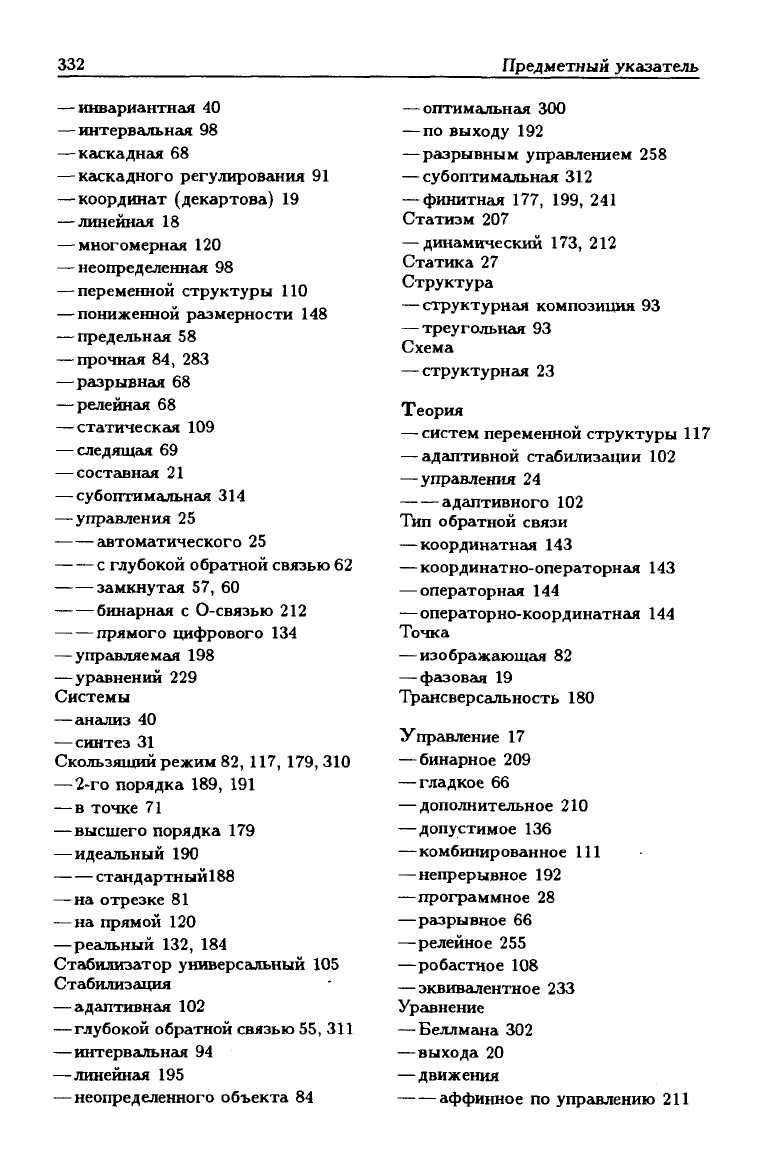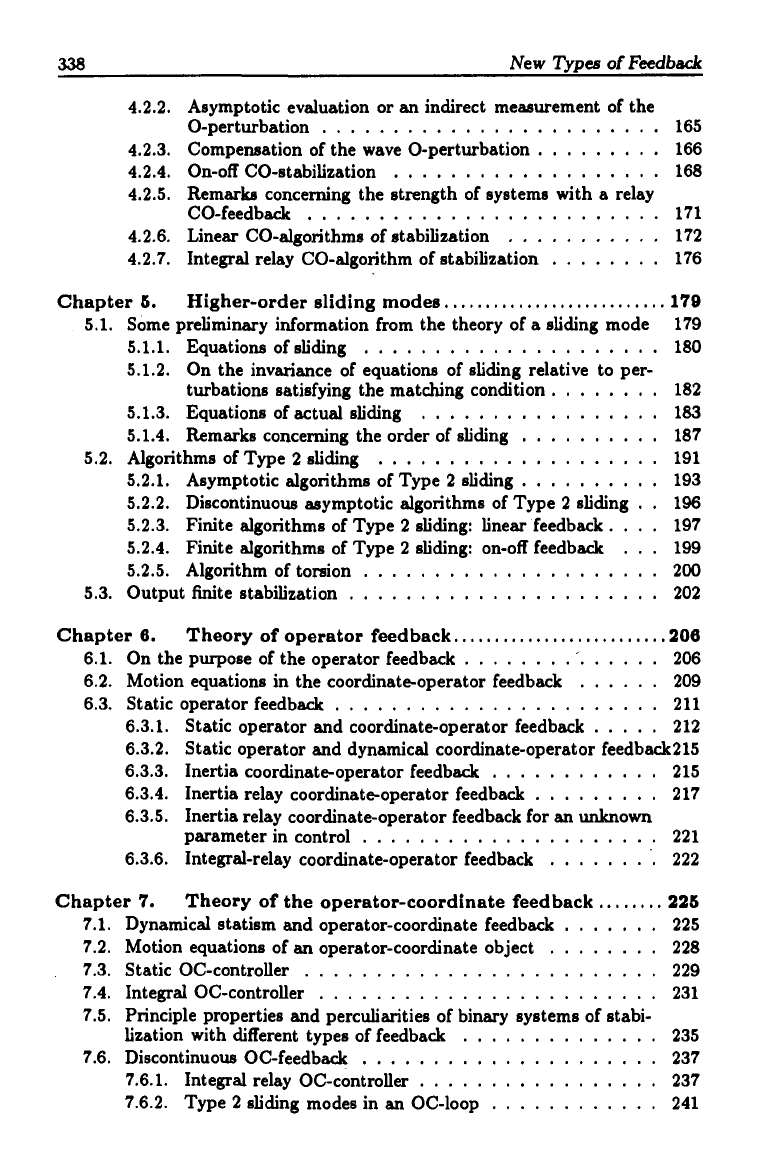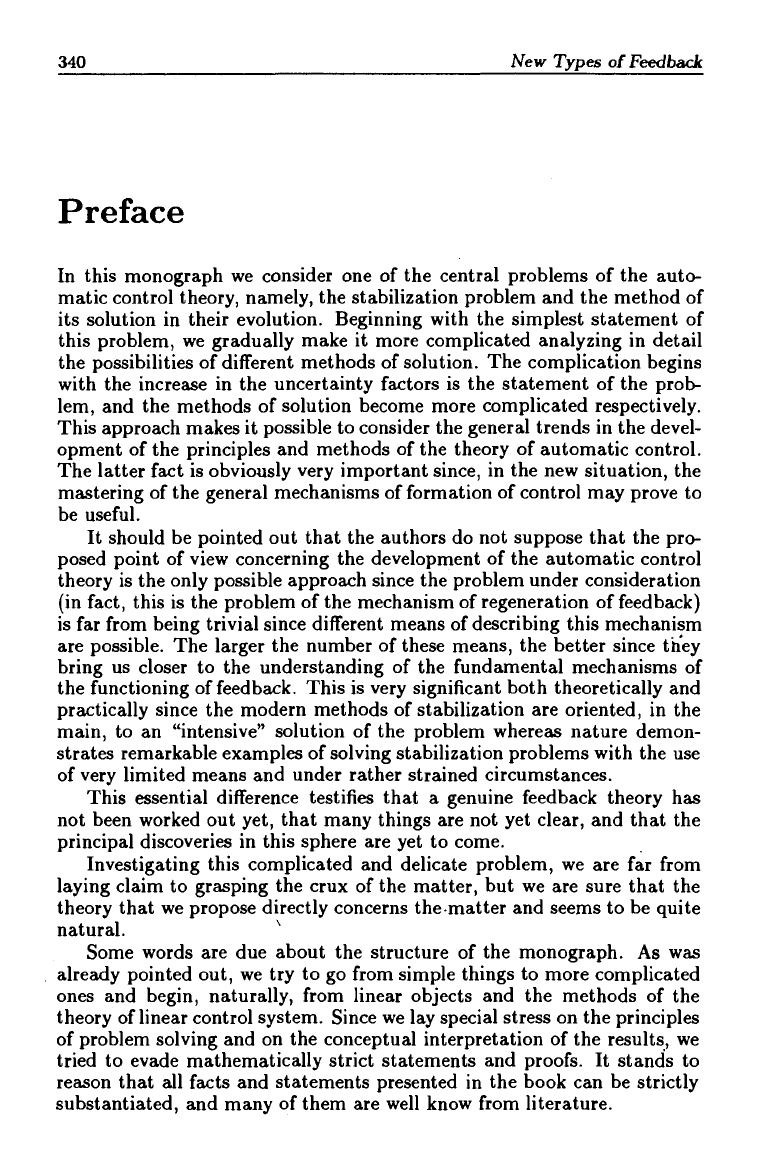Емельянов С.В. Новые типы обратной связи
Подождите немного. Документ загружается.


Предметный указатель
331
—покоя
27
—равновесия
114
Помеха
—постоянная
31
—
случайная
270
Порядок
—объекта
18
—
относительный
74
—первый
188
—по
параметру
Д 188
—
полинома
78
—
скольжения
179
—
ургшнения
19
Преобразование
—координат
159
—
Лапласа
18
одностороннее
18
—невырожденное
21
Принцип
—встроенной модели
48
—генерации
137, 148
—
двухканальности
40, 48
—кги:кадного регулирования
88
— К—^изображения 48
—
комбинированного
упргшления, 111
— компенсации, 34
—
максимума134
—
обратной связи
102
—
оптимальности
302
—переменности структуры
108, 120
—причинности
18
—регулирования
по
возмущению
32
—регулирования
по
нагрузке
29, 56
—регулирования
по
ошибке
56
—
скаляризахщи
157
Пространство
— КО 163
—состояний
19
—г фазовое
63
Процесс переходный
27
—
апериодический
174
—
колебательный
174
—
монотонный
196
Регулирующий орган
140
Регулятор
—
динамический
232
—линейный
68, 116
—нелинейный
67
—-переменной структуры
108
—
статический
229, 231
—
универсальный
107
Режим
—
переключений
117
—скользящий
191
идеальный
190
реальный
129, 183
Решение
—вынужденное
26
—
оптимальное (субоптимальное)
301
—переходное
27
—
ургшнения
26
—
установившееся
27
—
частное
26
Связь
— КО 215
динамическая
215
—компенсирующая
38
—
корректирующгкя
43
— О 208
отрицательная статическая
211
— ОК 227
—
обратная
20, 55
—по
возмущению
128
— по
заданию
26
—прямая
25
Сигнал
262
— К 138
—координата
138
— О, 138
—
оператор
138
Система
— адаптивная, 103
—
астатическая
109
—грубая
57
—
декомпозированная
45
—
динамическая
24
разрывнгш
67, 179
—
диссипативная
102

332
Предметный указатель
— инвариантная 40
—интервгшьная 98
—каскадная 68
— Ксъскадного регулирования 91
—координат (декартова) 19
—линейная 18
— многомерная 120
— неопределеннгья 98
—переменной структуры 110
—пониженной размерности 148
—предельнее 58
—прочная 84, 283
—разрывная 68
— релейная 68
— статическая 109
— следящсья 69
— составная 21
— субоптимальная 314
— управления 25
автоматического 25
с глубокой обратной связью 62
замкнутая 57, 60
6инарнс1я с
0-связью
212
прямого цифрового 134
— управляемая 198
— уравнений 229
Системы
— гшализ 40
—синтез 31
Скользящий режим 82, 117, 179, 310
— 2-го порядка 189, 191
— в точке 71
—высшего порядка 179
— идеальный 190
стандартный188
—на отрезке 81
— на прямой 120
— реальный 132, 184
Стабилизатор универсальный 105
Стабилизация
—адаптивная 102
—глубокой обратной связью 55, 311
—интервальнгш 94
—линейная 195
— неопределенного объекта 84
— оптимальнг1Я 300
— по выходу 192
—
разрывным управлением 258
— субоптимгишная 312
— финитная 177, 199, 241
Статизм 207
— динамический 173, 212
Статика 27
Структура
— структурная композиция 93
— треугольнгш 93
Схема
—структурная 23
Теория
— систем переменной структуры 117
— адаптивной стабилизации 102
— управления 24
адаптивного 102
Тип обратной связи
—координатная 143
— координатно-операторная 143
— операторная 144
— операторно-координатная 144
Точка
— изображающая 82
— фазовая 19
Трансверсальность 180
Управление 17
— бинарное 209
—гладкое 66
— дополнительное 210
— допустимое 136
—комбинированное 111
—непрерывное 192
—
программное 28
— разрывное 66
—релейное 255
—робастное 108
— эквивалентное 233
Уравнение
—
Беллмана 302
— выхода 20
— движения
аффинное по управлению 211

Предметный указатель
333
системы с глубокой обратной
связью 183
— дифференциального
минимакса 305
— дифференцисШЬНое с разрывной
правой частью 108
— наблюдателя относительно
ошибок 165
— неоднородное 26
— объекта в отклонениях 64
— однородное 26
— первого приближения 246
— состояния 20
— скольжения 83, 180
регшьного 184
— харгжтеристическое 30
— эталонной модели 306
Усилитель
— интегрирующий 140
— статический 140
Условие
— инвариантности 51
— квазистационарности 106
— компенсации, 32, 35
— МС (Matching Condition), 86, 182
— необходимое и достаточное по-
падания 125, 253
— неопределенности 56
— несмещенности 44
— согласованности 86, 100
— существования скользящего
режима 125
— устойчивости 58
— Харитонова 96
Устойчивость
— замкнутой системы 61
— асимптотическая 34
— интервальная 96
— нулей оператора 52
—положения равновесия 216
— свободного движения 31
— системы 63
— степень устойчивости 173
— экспоненциальная 48
Фаза 268
— фазовг1я плоскость 77
— фг^зовый портрет 65
— фг130вое пространство 64
— фазовая точка 20
Фильтр
— Винера 151
— Калмана-Бьюси 151
— предварительной обработки сиг-
нала 263
— сглаживающий 284
— стационарный 151
— формирующий 151
Фильтрация 264
Функция
— Беллмана 302
—
выхода 19
— дробно-рационг1льная 18
—задания 110
— комплексной переменной 18
— Ляпунова 75
— насыщения 66
— невырожденная 18
— оригинал, 18
—передаточная 18
нули передаточной функции 18
—пробная 196
— реле 66
Шар диссипативности 260
Экстремаль
— экстремалей поле 301, 303
Элемент
—билинейный 139
— бинарный 139
сепарабельный 140
— рг1зрывный 222
— сепарабельный 142
Эталонная модель 999
Ячейка
— ф 122
— "квг13ирелейное" представление
^-ячейки 128

Научное издание
ЕМЕЛЬЯНОВ Станислав Васильевич,
КОРОВИН Сергей Константинович
НОВЫЕ ТИПЫ ОБРАТНОЙ СВЯЗИ.
УПРАВЛЕНИЕ ПРИ НЕОПРЕДЕЛЕННОСТИ
Редактор Е.Ю. Звеэкинскад
Компьютерная графика Е.Ф. Тюриной, А.С. Фурсова
Компьютерная верстка А.П. Носова
ИБ №41861
ЛР
Х«
020297 от 27.11.91. Подписано в печать 16.06.97.
Формат 60x90/16. Бумага офсетная №1.
Печать офсетная. Усл. печ. л. 22. Уч.-изд. л. 24,2.
Тираж 1000 экз. Заказ тип. 1923 . С-014.
Издательскгъя фирма
«Физико-математическая литература» РАН
117071 Москва В-71, Ленинский проспект, 15
Отпечатано в Московской типографии Х*2 РАН
121099 Москва Г-99, Шубинский пер., 6

Institute for Systems Analysis
Moscow State University
New Types of Feedback
Control under Uncertainty
EMELYANOV S.V.
KOROVIN S.K.
The monograph is intended for a wide circle of specialists who are in-
terested in the problems of cybernetics, information science, automatic
control and optimization. We have made an attempt to give a system-
atized exposition of the main ideas and principles of the theory of control
systems with new types of feedback. The new theory can find divers ap-
plications, say, in solving problems of industrial automation by creating
a new generation of controllers which will efficiently control technological
processes under the conditions of great uncertainty and which will not re-
quire a regular adjustment of their parameters. The most important thing
is that this theory contains simple recurrent laws of synthesis of a poten-
tially arbitrarily complicated feedbewik which can cope with a nonstandard
uncertainty. In this respect, the new theory is a natural development of
the classical theory of automatic control and provides it with new tools
which make it possible to extend the capabilities of automatic systems.
Reviewers:
Academician of Russian Academy of Sciences V.P. Maslov
Academician of Russian Academy of Sciences Ya.Z. Tsypkin
Physical and Mathematical Literature Publishing Company,
Russian Academy of Sciences. Moscow, 1997, 352 p.
ISBN 5-02-015149-1

336 New Types of Feedback
Contents
Preface 8
Introduction 11
Part I
The main principles of design automatic control sys-
tems
Chapter 1. Principles of design linear automatic control systems 17
1.1. Statement of a control problems and preliminzu-ies 17
1.2. Principle of load control 28
1.3. Principle of perturbation control 31
1.4. Principle of compensation in an indirect meeisurement of pertiu--
bation 35
1.5. Double-channel principle 40
1.6. The method of /f-representation or the method of a built-in model 49
1.7. Deep feedback, namely, a high gedn 56
1.7.1. Statement of the problem, its peculicuities and the idea of
its solution 56
1.7.2.
Problems and limitations of the method of deep feedback 58
1.7.3. On the structural stability of systems with a deep feedback 62
1.7.4.
The method of the state space in the analysis of systems
with a deep feedback 64
1.7.5.
Geometrical interpretation of systems with a deep feedback 65
1.7.6.
The effect exerted by amplitude constraints on systems
with a deep feedback 65
1.8. Literciry comments 66
Chapter 2. Certain principles of constructing nonlinear
controllers 68
2.1.
On-off feedback 68
2.1.1.
Main concepts 68
2.1.2. Sliding mode at a point 71
2.1.3.
Switching mode 73
2.1.4. On the strength of a switching mode 75
2.1.5.
On-off stabilization of objects with self-levelling 76
2.1.6. On-off stabilization with a high relative order 78
2.1.7.
Robust stabilization: discontinuity, continuity, and infor-
mation concerning the state 78
2.1.8.
Robust stabiVzation of an object with the first relative order 80
2.1.9. Sliding mode on an interveJ 81
2.1.10. Actual sliding mode on an interveJ 82

Contents 337
2.1.11.
On-off stabilization of a generetlized object 83
2.2.
Stabilization of an object with an indefinite operator 84
2.2.1.
Basic principles 84
2.2.2. Principle of a cascade control 88
2.2.3.
Structure of objects with caiscade control 92
2.2.4. Stabilization of interval objects 94
2.2.5.
Interval stability 96
2.2.6. Bcksic principles of the adaptive stabilization theory . . . 100
2.3.
Stabilization by a controller with a V2u-ying structure 108
2.3.1.
Astatic servo system 109
2.3.2. Second order astatism 114
2.3.3.
Astatism of order m 115
2.3.4. Astatic servo system of varying structure 116
2.3.5.
Sliding mode on the whole straight line 120
2.3.6. Analysis of the strength of systems of varying structure
relative to perturbation parameters 123
2.3.7.
Systems of V£u-ying structure at the presence of an external
force 125
2.3.8.
Quasirelay representation of a ф-сеИ 128
2.3.9. Limitations, disadvantages, emd problems of the theory of
systems of varying structure 130
2.4. Literciry comments 131
Part II. New types of feedback
Chapter 3. Basic principles of the theory of new types of feed-
back 135
3.1.
Preliminaries 135
3.2. Systems of basic concepts 137
3.2.1.
Signal-operator 137
3.2.2. Types of dynamical objects 138
3.2.3.
Bineu-y operation 139
3.2.4. Types of controlling devices 140
3.2.5.
New types of feedbeick 140
3.3.
Structural synthesis of Ыпгц-у systems 141
3.3.1.
Stabilization of em indefinite object 141
3.3.2. Nonlinecu- feedback as a meeins of suppressing uncertainty 148
3.3.3.
Filtration problem 150
Chapter 4. Theory of the coordinate-operator feedback 154
4.1.
Stabilization of Type 2 object with unknown parameters and ex-
ternal action 155
4.1.1.
Scadarization principle and the equation of гт object in the
space of errors 156
4.1.2.
Some remarks concerning the statement of the problem
and its genercdization 157
4.1.3.
Coordinate-operator ph2kse sp2u;e 161
4.2.
CO-algorithms of stabiUzation 164
4.2.1.
Direct compensation 165

338 New Types of
Feedback
4.2.2.
Asymptotic evaluation or an indirect measurement of the
0-perturbation 165
4.2.3.
Compensation of the wave O-perturbation 166
4.2.4. On-ofT CO-stabilization 168
4.2.5. Remarks concerning the strength of systems with a relay
co-feedback 171
4.2.6. Linear CO-algorithms of stabilization 172
4.2.7. Integral relay CO-algorithm of stabilization 176
Chapter 5. Higher-order sliding modes 170
5.1.
Some preliminsu-y information from the theory of a sliding mode 179
5.1.1.
Equations of sliding 180
5.1.2. On the inviuisuice of equations of sliding relative to per-
turbations satisfying the matching condition 182
5.1.3.
Equations of actual sliding 183
5.1.4. Remarks concerning the order of sliding 187
5.2.
Algorithms of Type 2 sliding 191
5.2.1.
Asymptotic algorithms of Type 2 sliding 193
5.2.2. Discontinuous asymptotic algorithms of Type 2 sliding . . 196
5.2.3.
Finite algorithms of Type 2 sliding: linear feedback .... 197
5.2.4. Finite algorithms of Type 2 sliding: on-off feedback . . . 199
5.2.5. Algorithm of torsion 200
5.3.
Output finite stabilization 202
Chapter 6. Theory of operator feedback 206
6.1.
On the purpose of the operator feedback 206
6.2. Motion equations in the coordinate-operator feedbeick 209
6.3.
Static operator feedbitck 211
6.3.1.
Static operator and coordinate-operator feedback 212
6.3.2. Static operator and dynamical coordinate-operator feedback215
6.3.3. Inertia coordinate-operator feedbiick 215
6.3.4. Inertia relay coordinate-operator feedback 217
6.3.5. Inertia relay coordinate-operator feedback for an unknown
parameter in control 221
6.3.6. Integral-relay coordinate-operator feedback 222
Chapter 7. Theory of the operator-coordinate feedback 225
7.1.
Dynamical statism and operator-coordinate feedback 225
7.2.
Motion equations of an operator-coordinate object 228
7.3.
Static OC-controller 229
7.4. Integral OC-controller 231
7.5. Principle properties and perculisirities of biniiry systems of stabi-
lization with different types of feedback 235
7.6. Discontinuous OC-feedback 237
7.6.1.
Integral relay OC-controller 237
7.6.2. Type 2 sliding modes in an OC-loop 241

Contento 339
Chapter 8. Limitatione, the physical foundations of the compen-
sation of perturbations, and the stabilization of forced motion
in bynary systems 246
8.1.
Constraint on the operator variable 247
8.2. On the global behavior of a binary system 252
8.3.
Physical foundations of the compensation of uncertainty 255
8.4. On the compensation of the coordinate perturbation 256
Chapter 0. Differentiation of signals 262
9.1.
Statement of the dufferentiation problem 262
9.1.1.
Filtration 264
9.1.2. RC-chain 265
9.1.3.
Discrete-difference approximations 269
9.2. Differentiating servo systems 271
9.2.1.
Linear differentiator 272
9.2.2. Relay differentiator 276
9.2.3.
Differentiator of a varying structure 280
9.3.
Asymptotic binary servo differentiator 283
9.4. Finite binary differentiator 287
9.5.
Nonstandard differentiating systems 288
9.5.1.
Differentiator with a "small" amplitude of discontinuities 289
9.5.2. Nonstandard binary differentiator 291
9.5.3.
Results of discrete simulation of a nonstandard Ыпги-у
dif-
ferentiator 297
Chapter 10. Suboptimal stabilization of an uncertain plant 300
10.1.
Statement of the optimal stabilization problem 300
10.2.
Example of an optimal stabilization problem under imcertainty . 302
10.3.
Optimal stabilization "in the mean" 303
10.4.
Minimax optimal stabilization 304
10.5.
Stabilization with the use of a reference model and deep feedback 306
10.6.
Stabilization with the methods of the binary control theory . . . 308
10.6.1.
System of a variable structure 310
10.6.2.
Binary stabilization with the integral CO-feedback .... 311
10.6.3.
Stabilization with the use of Type 2 sliding 312
10.7.
Reduction of the problem of suboptimetl stabilization to that of
asymptotic invariance 313
10.7.1.
Basic concepts of the asymptotic invariance theory .... 314
10.7.2.
Suboptimal lineskrly quadratic stabilization 316
Conclusion 319
References 322
Index 328

340 New Types of
Feedback
Preface
In this monograph we consider one of the central problems of the auto-
matic control theory, namely, the stabilization problem and the method of
its solution in their evolution. Beginning with the simplest statement of
this problem, we gradually make it more complicated analyzing in detail
the possibilities of different methods of solution. The complication begins
with the increase in the uncertainty factors is the statement of the prob-
lem, and the methods of solution become more complicated respectively.
This approach makes it possible to consider the general trends in the devel-
opment of the principles and methods of the theory of automatic control.
The latter fact is obviously very important since, in the new situation, the
mastering of the general mechanisms of formation of control may prove to
be useful.
It should be pointed out that the authors do not suppose that the pro-
posed point of view concerning the development of the automatic control
theory is the only possible approach since the problem under consideration
(in fact, this is the problem of the mechanism of regeneration of feedback)
is far from being trivial since different means of describing this mechanism
are possible. The larger the number of these means, the better since they
bring us closer to the understanding of the fundamental mechanisms of
the functioning of feedbeick. This is very significant both theoretically and
practically since the modern methods of stabilization are oriented, in the
main, to an "intensive" solution of the problem whereas nature demon-
strates remarkable examples of solving stabilization problems with the use
of very limited means and under rather strained circumstances.
This essential difference testifies that a genuine feedback theory has
not been worked out yet, that many things are not yet clear, and that the
principal discoveries in this sphere are yet to come.
Investigating this complicated and delicate problem, we are far from
laying claim to grasping the crux of the matter, but we are sure that the
theory that we propose directly concerns the matter and seems to be quite
natural.
Some words are due about the structure of the monograph. As was
already pointed out, we try to go from simple things to more complicated
ones and begin, naturally, from linear objects and the methods of the
theory of linear control system. Since we lay special stress on the principles
of problem solving and on the conceptual interpretation of the results, we
tried to evade mathematically strict statements and proofs. It stands to
reason that all f2icts and statements presented in the book can be strictly
substantiated, and many of them are well know from literature.
